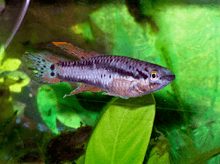Aphyosemion bivittatum
| Aphyosemion bivittatum | |
|---|---|
 | |
| Aphyosemion bivittatum Male | |
| Conservation status | |
| Scientific classification | |
| Kingdom: | Animalia |
| Phylum: | Chordata |
| Class: | Actinopterygii |
| Order: | Cyprinodontiformes |
| Family: | Nothobranchiidae |
| Genus: | Aphyosemion |
| Species: | A. bivittatum |
| Binomial name | |
| Aphyosemion bivittatum (Lönnberg, 1895) | |
| Synonyms | |
| |
Aphyosemion bivittatum (Twostripe Lyretail, Two-banded Killi, Red Lyretail) is a species of freshwater fish belonging to the Nothobranchiidae family. It is found in rivers in southeastern Nigeria and southwestern Cameroon.[1]
Appearance
A. bivittatum has an elongated brightly coloured body with two dark bands running along each side. The males have a maximum body length of approximately 5 cm. It has 10–13 spines in its dorsal fin and 12-15 in its anal fin.[2]
Habitat
The species is found in small calcium rich steams in the coastal rainforests of southeastern Nigeria and southwestern Cameroon. They are benthopelagic, meaning they float just above the riverbed.[1] They prefer water with a pH of 6 to 6.5 and temperature of 22 to 24oC.[3][4]
A bivittatum has only been observed in five locations and it is thought that they are present in no more than ten. This, along with the threat to their habitat from deforestation, has led them to be classified as vulnerable.[1]
References
- ↑ 1.0 1.1 1.2 1.3 Lalèyè, P. & Olaosebikan, B.D. (2010). "Aphyosemion bivittatum". IUCN 2013. IUCN Red List of Threatened Species. Version 2013.1. Retrieved 8 August 2013.
- ↑ Huber, J.H., (1996). "Killi-Data 1996. Updated checklist of taxonomic names, collecting localities and bibliographic references of oviparous Cyprinodont fishes (Atherinomorpha, Pisces)". Société Française d'Ichtyologie, Muséum National d'Histoire Naturelle: 399.
- ↑ Riehl, R. and H.A. Baensch, (1991). Aquarien Atlas Volume 1. Germany: Melle: Mergus, Verlag für Natur-und Heimtierkunde. p. 992.
- ↑ "Aphyosemion bivittatum (Lönnberg, 1895)". Fish Base. Retrieved 8 August 2013.
External links
 Data related to Aphyosemion bivittatum at Wikispecies
Data related to Aphyosemion bivittatum at Wikispecies
